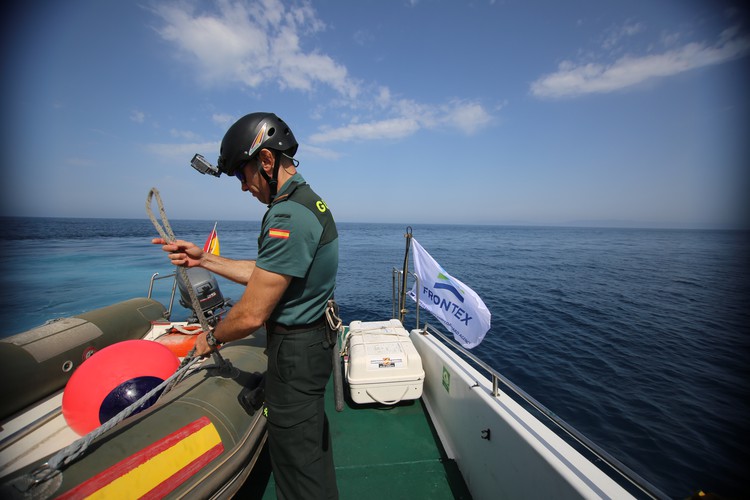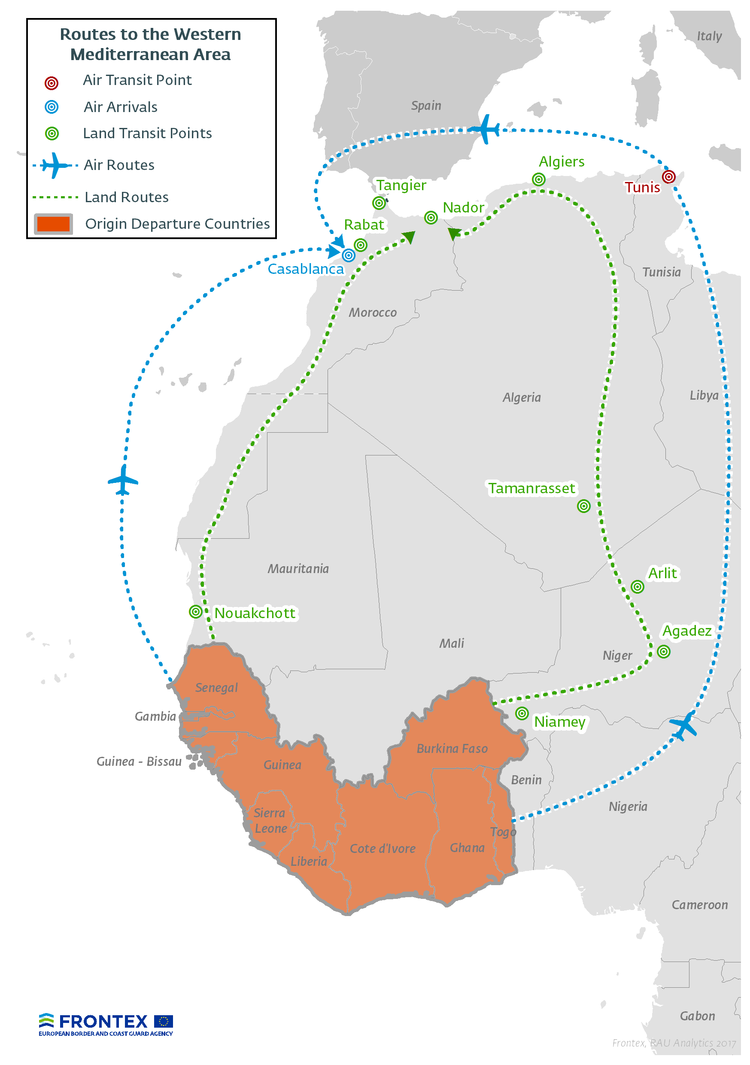Frontex, the European Border and Coast Guard Agency, assists Spain in dealing with various types of cross-border crime, including people smuggling, as well as trafficking of drugs, weapons and cigarettes. Frontex supports the national authorities with border control and surveillance, identification and registration and its ships and airplanes contribute to search and rescue operations.
News
Focus on Western Mediterranean route: Frontex in Spain
2017-08-03

Migratory situation on the Western Mediterranean Route to Spain
The area stretching between Spain and Morocco, known as the Western Mediterranean route, has long been used by migrants. For many years, it has also been the main route used by criminal networks to smuggle narcotics into the EU.
The cooperation between Spain, Morocco and Algeria and their active role in border surveillance is an important factor for the control of the migratory flows in the Western Mediterranean Sea.
However, this year, there has been a steady increase in irregular migration from the African continent, especially from West Africa.
The main reasons for this increase is the instability in the countries of origin and transit. Despite the increasing smuggling prices this year, the Western Mediterranean Route is still more affordable compared with other maritime routes. An important factor in this context is also the short distance between the departure points and the Spanish shores. The recent use of powerful speed boats (usually involved in hashish smuggling), which can transport large numbers of migrants in a shorter time, could be another reason in the increasing number of arrivals. In addition, the dismantling of makeshift migrant camps in Morocco and Algeria might act as a ‘push factor’ in displacing migrants to other areas.
The presence of a large West African diaspora in Europe and the remittances sent by migrants to their families back home are some of the many pull factors. Relatives or friends who have made the crossing often provide contacts of trustworthy smugglers in the departure countries.
A decade ago, the vast majority of migrants traveling from Morocco to Spain were typically economic migrants from Algeria and Morocco, hoping to find jobs in Europe. Since then, they have increasingly been joined by sub-Saharan Africans, driven northwards by conflicts in Mali, Sudan, Cameroon, Nigeria, Chad and the Central African Republic. In the first quarter of this year, the number of illegal border crossings detected in the Western Mediterranean almost tripled compared with the same period last year, seeing the highest migrations flow on this route since 2009. Migrants from the Ivory Coast, Guinea and Gambia accounted for the highest number of arrivals.

The main challenges for border control also include combatting different types of cross-border crime and the expansion of terrorist activities in Northern Africa. As part of its support to the Spanish authorities in addressing these challenges, Frontex currently deploys in Spain more than 180 officers from several European countries who assist with border checks, help register migrants and collect information on criminal smuggling networks, which is shared with national authorities and Europol in support of criminal investigations. They also provide support in identifying vulnerable migrants, such as victims of trafficking, including those in need of international protection. Finally, Frontex also helps Spanish authorities to seize drugs, weapons and cigarettes.
Routes from Sub-Saharan Africa to departure areas
From West Africa, most migrants head to Algeria and Morocco via Agadez, Niger’s largest city and home to many smuggling networks. Other land routes from West Africa lead along the western coast of Western Sahara and Morocco, through Mauritania and the desert into Morocco. The alternative route across Mali is considered too dangerous. More affluent migrants can fly directly to Casablanca from Western African countries and then to Tangier and to Europe via the Strait of Gibraltar.
Morocco and Algeria are countries of both transit and origin. In 2017, Morocco continues to be the main departure country for migrants willing to reach the southern coast of Spain.
Methods used by people smugglers
People smugglers profit from the increasing number of migrants and increase their prices. While a year ago, the average price to cross from the Moroccan coast to Spain was around EUR 500, now the price has doubled. Smugglers offer different packages, depending on the wealth of their clients – some even include multiple attempts. Migrants on this route can cross on the cheapest toy dinghies, larger rubber boats, inflatable boats with a powerful engine, a speed boat or even jet skis.
Sub-Saharan Africans reach Europe with the help of local Moroccan people smugglers. They pay between EUR 100-1 500 to cross to Spain, depending on the crossing area and the type of boat used. They are typically recruited by fellow countrymen working for the Moroccan smugglers. Unlike on the Eastern Mediterranean route, they tend to rely on personal connections and recommendations from friends or family members rather than gathering information from the social media or open sources.
In the Strait of Gibraltar, some Sub-Saharan migrants also organise the crossing themselves on toy rubber dinghies, the cheapest and most dangerous means of transport used on this route. In this part of the Mediterranean Sea, the crossing is highly dependent on weather conditions. Departure places and the types of vessels used are constantly changing. The toy boats, usually used on summer holidays, are unfit for high sea conditions; they carry around twelve to fifteen people and can capsize within minutes.
A more expensive option, usually chosen by Moroccan migrants, are inflatable boats with powerful engines that can make the crossing to Spain quickly and can carry from 30 to 60 migrants.
Frontex has also noted some cases of migrants trying to cross the Strait of Gibraltar using jet skis. This can take around 30 minutes and can be quite costly – on average, migrants have to pay around 3000 euro to get to Europe. Usually the smuggler leaves the migrant on the shore and then quickly makes the way back to the Western African coast.
A big challenge for law enforcement authorities on this route are clandestine entries – some migrants hide in ferries in an attempt to reach Spain.
The role of Frontex in Spain
Frontex, the European Border and Coast Guard Agency, has long been helping Spain with four operations covering the country’s sea borders: operations Indalo, Hera, Minerva and Focal Points Sea.
The operations usually run from May to October every year, covering the months of the highest migratory pressure. The agency helps Spain with border security, identifying possible risks and threats and information exchange. Frontex also assists with checking documents of regular passengers from non EU countries during peak summer months.
Since the beginning of the Joint Operation Indalo 2017 in May this year, over 16 tonnes of hashish and 64 million cigarettes have been seized.